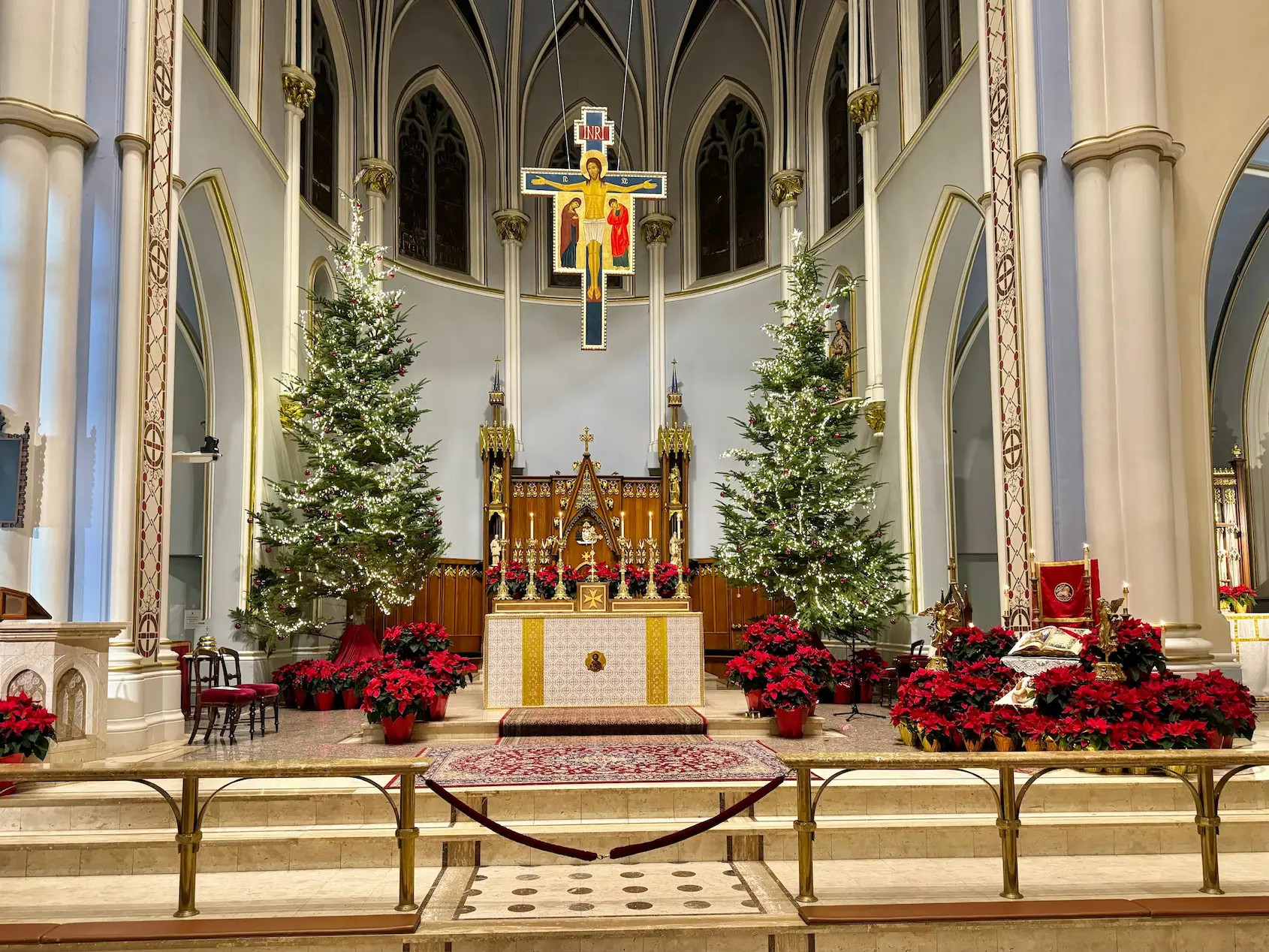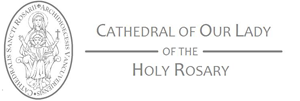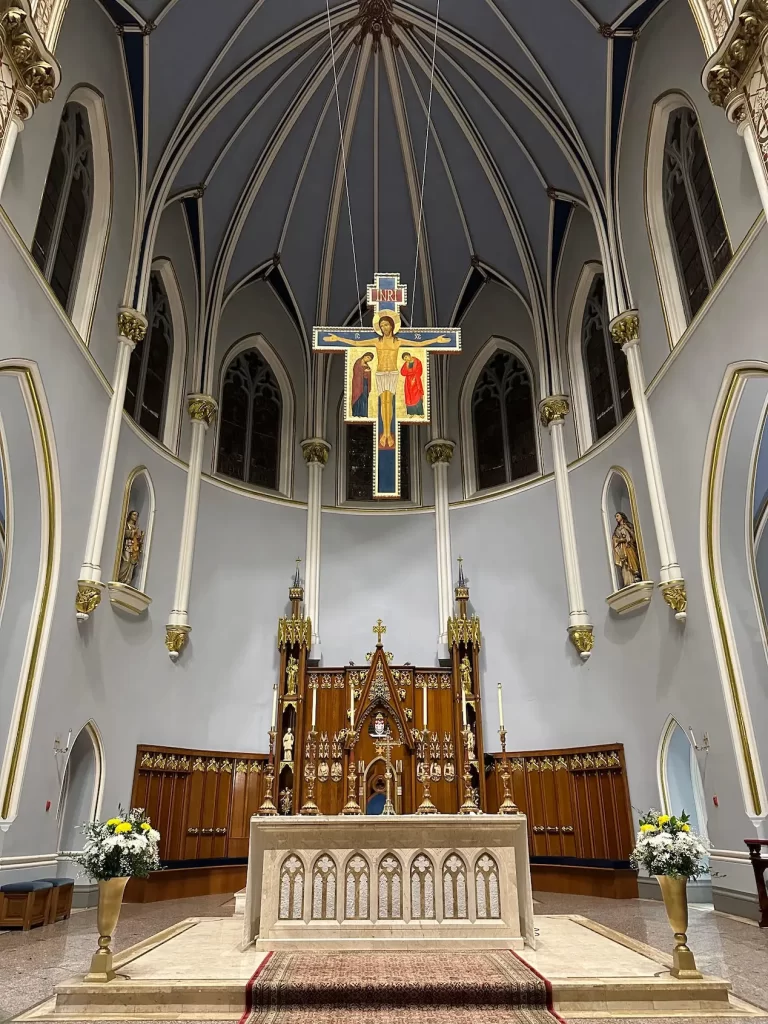HRC Tour
The High Altar of the Cathedral
It is called the high altar because it is the main altar of a church, and also because it is located on a high plane in the chancel, where all the faithful in the church body can see it simultaneously. It symbolises Christ, and serves at the same time as the banquet table at which He offers Himself to the Eternal Father through the hands of the priest, for Christ is present in our churches not only in a spiritual way, but really, truly and substantially as the victim of a sacrifice.
A sacrifice necessarily presupposes a priest and an altar, and the Acts of the Apostles (2:42) clearly indicates that the faithful are to participate in the prayers of the sacrifice and eat of the victim. Naturally, the altar and the priest were separate from the faithful, who, as St. Athanasius (Quaest. Ad Ant., 37) and Clement of Alexandria (Strom., VII, 7) inform us, were instructed by the Apostles to pray facing east, according to the traditions of the Law of Moses. Hence, in the early days of the Church, the altar was usually placed in a chapel at the head of the building, the back of which, whatever may have been the character of the building, faced directly to the east, so that the faithful could see it from anywhere.
In ancient times there was only one altar in a church. The Church Fathers speak of a single altar, and St. Ignatius (Ep. ad Philadelph, 5.) refers to this practice when he says: ‘One altar, since there is one bishop’ (unum altare omni Ecclesiae et unus episcopus). This altar was erected in the centre of the presbytery between the bishop’s throne, which was situated in the apse, and the communion rail, which separated the presbytery from the body of the church. Here the bishop celebrated the Holy Eucharist and was assisted by deacons, who received Holy Communion from his hands. Although each church had a single altar, there were chapels erected near or around the church where Mass was celebrated. This custom is still maintained throughout the East, so that the liturgical or high altar of solemn sacrifice is isolated from what might be called the altars of devotional sacrifice where the Mass is said in private. Later, in the time of St. Ambrose (4th century), we find the custom of having more than one altar in a church; and St. Gregory (6th century) evidently approves of it by sending to Palladius, bishop of Saintes, France, relics for four altars which, of the thirteen erected in his church, could not be consecrated for lack of relics. After the introduction of private Masses, the need arose for several or even many altars in each church; these were erected near the main altar or in the side chapels. The altar in the presbytery, or high chapel, remained the main altar of the church, and pontifical ceremonies in cathedrals, as well as solemn functions in other churches, invariably took place at the high altar on Sundays, feast days and other solemn occasions of the year.
The High Altar of the Cathedral
HRC Tour
It is called the high altar because it is the main altar of a church, and also because it is located on a high plane in the chancel, where all the faithful in the church body can see it simultaneously. It symbolises Christ, and serves at the same time as the banquet table at which He offers Himself to the Eternal Father through the hands of the priest, for Christ is present in our churches not only in a spiritual way, but really, truly and substantially as the victim of a sacrifice.
A sacrifice necessarily presupposes a priest and an altar, and the Acts of the Apostles (2:42) clearly indicates that the faithful are to participate in the prayers of the sacrifice and eat of the victim. Naturally, the altar and the priest were separate from the faithful, who, as St. Athanasius (Quaest. Ad Ant., 37) and Clement of Alexandria (Strom., VII, 7) inform us, were instructed by the Apostles to pray facing east, according to the traditions of the Law of Moses. Hence, in the early days of the Church, the altar was usually placed in a chapel at the head of the building, the back of which, whatever may have been the character of the building, faced directly to the east, so that the faithful could see it from anywhere.
In ancient times there was only one altar in a church. The Church Fathers speak of a single altar, and St. Ignatius (Ep. ad Philadelph, 5.) refers to this practice when he says: ‘One altar, since there is one bishop’ (unum altare omni Ecclesiae et unus episcopus). This altar was erected in the centre of the presbytery between the bishop’s throne, which was situated in the apse, and the communion rail, which separated the presbytery from the body of the church. Here the bishop celebrated the Holy Eucharist and was assisted by deacons, who received Holy Communion from his hands. Although each church had a single altar, there were chapels erected near or around the church where Mass was celebrated. This custom is still maintained throughout the East, so that the liturgical or high altar of solemn sacrifice is isolated from what might be called the altars of devotional sacrifice where the Mass is said in private. Later, in the time of St. Ambrose (4th century), we find the custom of having more than one altar in a church; and St. Gregory (6th century) evidently approves of it by sending to Palladius, bishop of Saintes, France, relics for four altars which, of the thirteen erected in his church, could not be consecrated for lack of relics. After the introduction of private Masses, the need arose for several or even many altars in each church; these were erected near the main altar or in the side chapels. The altar in the presbytery, or high chapel, remained the main altar of the church, and pontifical ceremonies in cathedrals, as well as solemn functions in other churches, invariably took place at the high altar on Sundays, feast days and other solemn occasions of the year.
When the custom of erecting the episcopal throne on the Gospel side of the presbytery became normalized during the Carolingian period, the high altar was set back closer to the apse wall. The object of this was to allow sufficient space between the lowest step of the altar and the communion rail (from six to twelve feet) for the proper performance of the ceremony, and for the accommodation of the clergy who often assisted in the solemn celebration of the Mass and divine offices in large numbers. The high altar was built on steps, which for symbolic reasons were usually in odd numbers – three or five, including the upper platform (predella) and the pavement of the sanctuary, thus placing it on a higher level than the body of the church, a practice which is still maintained in our churches. In parish churches the Blessed Sacrament is usually kept in the high altar, which should therefore have a tabernacle for the reservation of the sacred species (S.R.C., 28 Nov. 1594, 21 Aug. 1863).
The prescribed ornaments are a crucifix and six tall candlesticks. The high altar of a church to be consecrated must be a fixed altar, which, according to the prescriptions of the Roman Pontifical, is itself to be consecrated simultaneously with the solemn dedication of the church building. It must therefore be free on all sides, leaving sufficient space for the consecrator to move around it. As its name indicates, the high altar, being the main place for the performance of the sacrificial function, should be prominent not only by its position, but also by the richness of its materials and ornamentation. In addition to the liturgical part of the Mass, it serves as a monument of the Eucharistic presence and becomes the centre of all the most solemn parish functions of the year.
The Cathedral originally had a high altar at the apse which was not free standing. Some of the reredos of the original altar now adorn the place where the throne of the Archbishop of Vancouver is. The original high altar was made of wood and remained there until in 1982 Monsignor David Monroe, then rector of the Cathedral commissioned a new one made of marble in preparation for the visit of Pope John Paul II. The altar was made in neo-gothic style with a matching lectern. This altar was made free-standing so that it can be easily incensed at solemn ceremonies and also so that it can be used ad orientem or facing liturgical east. The altar of the Cathedral is ornamented with six candles and a crucifix. The style of the candles usually is determined by the liturgical season.
When the custom of erecting the episcopal throne on the Gospel side of the presbytery became normalized during the Carolingian period, the high altar was set back closer to the apse wall. The object of this was to allow sufficient space between the lowest step of the altar and the communion rail (from six to twelve feet) for the proper performance of the ceremony, and for the accommodation of the clergy who often assisted in the solemn celebration of the Mass and divine offices in large numbers. The high altar was built on steps, which for symbolic reasons were usually in odd numbers – three or five, including the upper platform (predella) and the pavement of the sanctuary, thus placing it on a higher level than the body of the church, a practice which is still maintained in our churches. In parish churches the Blessed Sacrament is usually kept in the high altar, which should therefore have a tabernacle for the reservation of the sacred species (S.R.C., 28 Nov. 1594, 21 Aug. 1863).
The prescribed ornaments are a crucifix and six tall candlesticks. The high altar of a church to be consecrated must be a fixed altar, which, according to the prescriptions of the Roman Pontifical, is itself to be consecrated simultaneously with the solemn dedication of the church building. It must therefore be free on all sides, leaving sufficient space for the consecrator to move around it. As its name indicates, the high altar, being the main place for the performance of the sacrificial function, should be prominent not only by its position, but also by the richness of its materials and ornamentation. In addition to the liturgical part of the Mass, it serves as a monument of the Eucharistic presence and becomes the centre of all the most solemn parish functions of the year.
The Cathedral originally had a high altar at the apse which was not free standing. Some of the reredos of the original altar now adorn the place where the throne of the Archbishop of Vancouver is. The original high altar was made of wood and remained there until in 1982 Monsignor David Monroe, then rector of the Cathedral commissioned a new one made of marble in preparation for the visit of Pope John Paul II. The altar was made in neo-gothic style with a matching lectern. This altar was made free-standing so that it can be easily incensed at solemn ceremonies and also so that it can be used ad orientem or facing liturgical east. The altar of the Cathedral is ornamented with six candles and a crucifix. The style of the candles usually is determined by the liturgical season.



